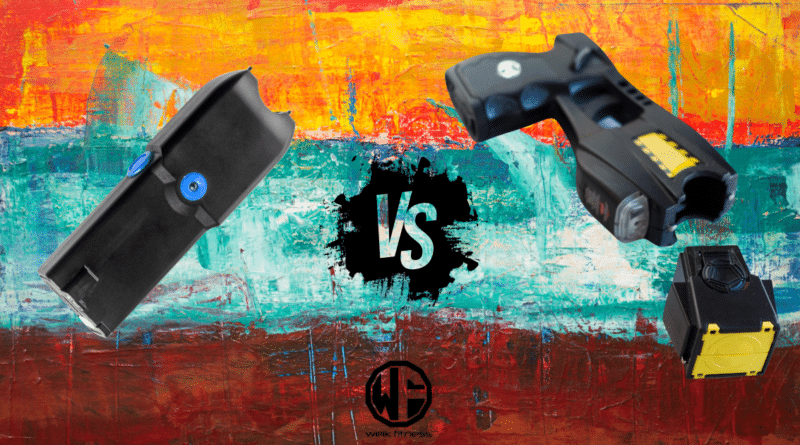Stun Gun vs Taser: Are They Good for Self-Defense?
Navigating the maze of self-defense tools can feel overwhelming. You have items like OC spray, defensive blades, and concealed carry firearms. Amid a sea of options, deciding whether a stun gun or taser is your ally for personal safety isn’t exactly straightforward. The dilemma between stun gun vs taser can be complicated, and it’s possible that neither is the right choice for you.
I understand this dilemma all too well — pondering over how to ensure my own security (as well as thinking of options that my wife can carry) without stepping into a territory where your options are limited.
In my quest for answers, I dove headfirst into research and hands-on testing with various devices. This process illuminated some distinct differences between stun guns and tasers that could light the way for others who were in the same scenario I was.
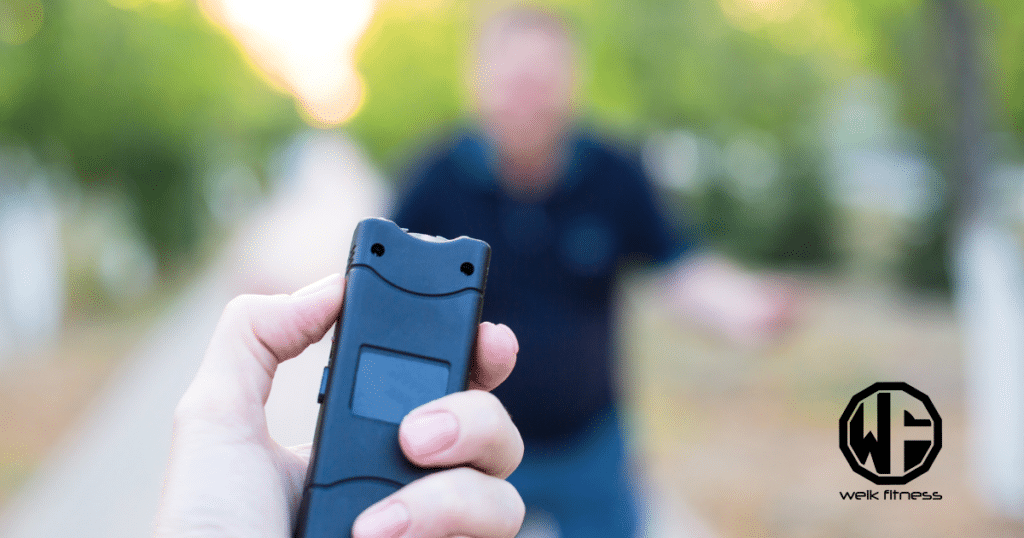
This article aims to demystify how each of these self-defense weapons operates, laying out their pros and cons, alongside considerations that might tilt your decision towards one or the other as a self-protection option.
Whether your priority lies with portability or striking from a safe distance, we’re here to guide you through. Your safety is paramount — let’s dive into this together!
Table of Contents
Key Takeaways
- Stun guns give a high-voltage shock that stops an attacker by making it hard for them to move. These devices need you to be close to use them.
- Tasers can shoot darts up to 15 feet away, freezing an attacker by messing with their nervous system. This lets you stay farther from danger.
- While stun guns are small and easy to take around, they only work when you’re very close to the person you want to stop. Tasers give you more space but can cost a lot more money.
- Both stun guns and tasers don’t cause lasting harm, making them good choices for keeping yourself safe without using deadly force.
- Picking between a stun gun vs taser depends on what feels right for you, how much money you want to spend, and if you’d rather keep distance between yourself and an attacker.
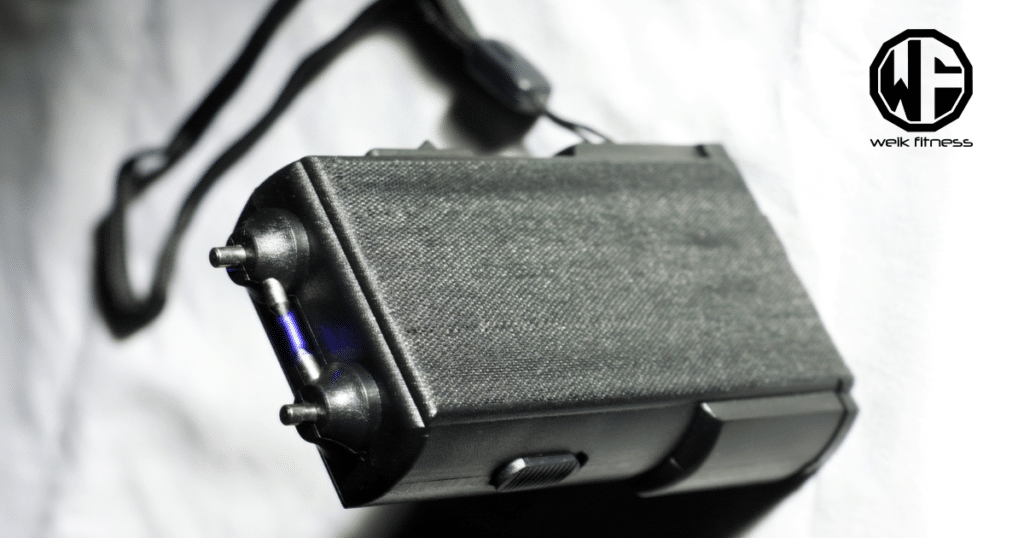
How Does a Stun Gun and Taser Work?
Stun guns use electric shock to disable attackers, while tasers work by using electrical currents to disrupt the nervous system. This can immobilize an assailant and give the victim time to escape.
1. Stun guns use electric shock to disable an attacker
I’ve used a stun gun before, and let me tell you, it’s all about delivering a high-voltage shock. This isn’t just any shock; it’s designed to stop an aggressor in their tracks by momentarily taking out muscle control.
Imagine your attacker frozen, unable to move because you’ve hit them with this powerful jolt of electricity.
A momentary zap can save the day.
These devices are not toys. They’re hand-held guardians powered by batteries ready to defend at close range. You need direct contact with the assailant for it to work, meaning you have to be within arm’s reach.
But when that distance closes, a stun gun may be your best ally, making sure the last thing an attacker remembers is your counter-move of self-defense.
One stun gun that seems to be recommended quite often is this VIPERTEK model.
2. Tasers use electrical currents to disrupt the nervous system
Tasers shoot darts connected to wires that deliver electrical currents. These currents mess with the nervous system. The attacker’s muscles lock up, making them unable to move for a bit.
This gives me time to get away or call for help. The best part? Tasers work from up to 15 feet away. I don’t have to wait until the threat is too close.
Using a taser didn’t cause long-term harm, in my experience, which matches what experts say. It doesn’t make the muscle enzymes go haywire, leading to damage.
Plus, there was this one time it made an attacker forget what happened right before I used it on him — an unexpected but useful effect when you need those crucial moments of advantage.
One taser that seems to be recommended quite often is this TASER Bolt model.
Pros and Cons of a Stun Gun vs Taser
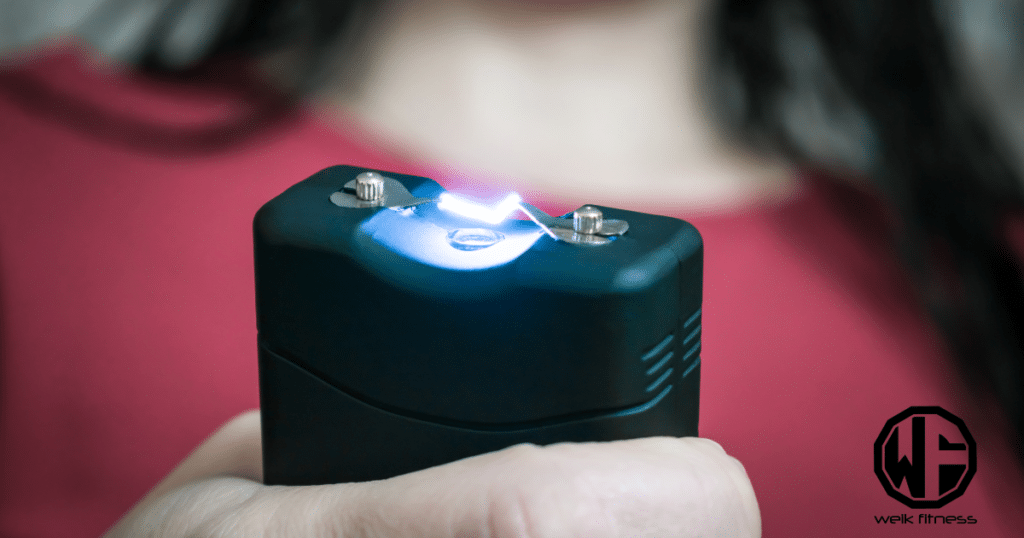
Stun guns are compact and easy to carry, while tasers have a longer range and can be used from a distance. Stun guns require close contact with an attacker, whereas tasers can be expensive and may cause serious injury.
Additionally, you need to know the state and local laws where you live, as they may already dictate your choice when looking at a stun gun vs taser. There are certain stun gun laws and taser laws that you need to follow in various states.
1. Stun guns are compact and easy to carry for personal safety
Carrying a self-defense tool should never feel like a burden. That’s why many people appreciate compact stun devices. Their size and design makes carrying a stun gun easy to slip into a pocket or purse, ready at a moment’s notice. Some even have a flashlight.
Unlike larger options that might stay at home on the shelf, these fit seamlessly into daily life for self defense. They may be good for those who aren’t comfortable carrying a firearm, too.
When it comes down to it, the best defense tool is the one you have with you.
Think about walking through a parking lot late at night or navigating an unfamiliar neighborhood; having something as manageable and discreet as a mini shock device offers peace of mind without drawing unwanted attention.
Plus, their rechargeable feature means they’re always ready for action without the extra cost of batteries or cartridges — making them not only convenient but economical, too. Sabre makes some good stun guns, but there is a wide variety of stun guns on the market.
2. Tasers have a longer range and can be used from a distance
Tasers can be used from a distance, thanks to their longer range compared to stun guns. This means you can incapacitate an attacker without getting up close by shooting out the barbs and activating the electrode. Tasers shoot two darts or probes at the target, making them effective even from afar.
This provides a level of safety and control, especially in high-stress situations.

Tasers are designed to immobilize targets from a safe distance by shooting out two darts or probes. This feature makes them ideal for self-defense scenarios where maintaining distance is crucial for personal safety.
That said, if you deploy the taser, you’ll need a new cartridge. Therefore, you need to factor in how much the cartridges cost, as the taser cartridge could be costly to replace.
3. Stun guns require close contact with an attacker
Stun guns need direct contact with the assailant to work. They only provide an electric shock when you touch the attacker. It’s crucial to remember that their effectiveness is limited by your physical proximity.
When it comes to self-defense, stun guns require close contact with the aggressor.
Honestly, I don’t like this idea, but that’s my personal opinion. I don’t want any aggressor or attacker getting close enough to me that I can reach out and touch them if I had to, nor do I want a man getting that close to my wife where they can overpower her.
4. Tasers can be expensive and may cause serious injury
Tasers can be quite pricey, often costing several hundred dollars. Additionally, using a taser device in drive (or touch) stun mode can lead to permanent scarring and other severe injuries on a target.
The unit itself and the ammo cartridges for tasers tend to be more costly than typical stun guns.
Which Option Between Stun Guns and Tasers is Best for Self-Defense?
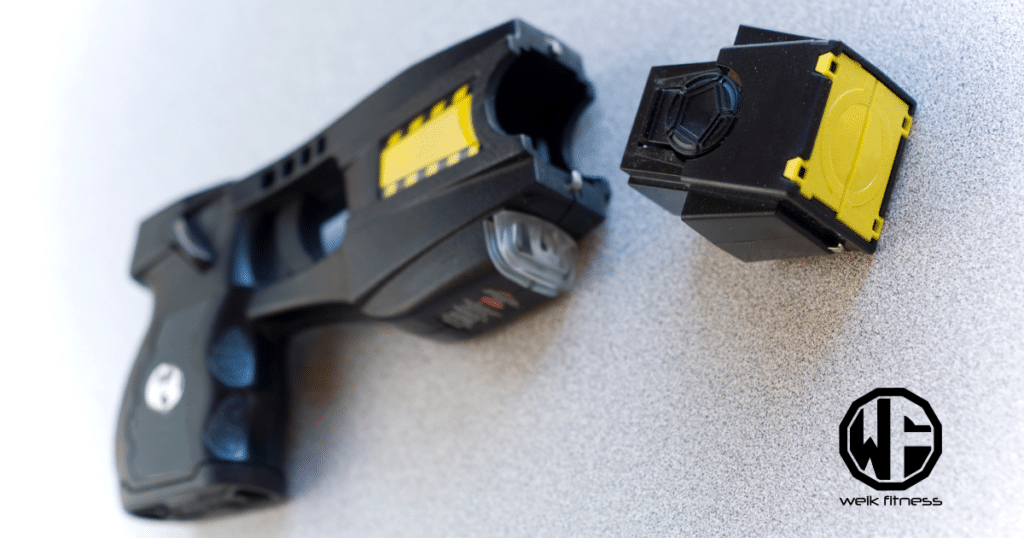
When choosing self-defense options, consider your needs and budget when looking at a stun gun vs taser.
Both a taser or a stun gun can be effective for personal safety. To explore more about the best choice for you, let’s dive even further into our comprehensive guide on stun guns vs tasers.
1. A stun gun vs taser depends on individual preferences and needs
When it comes to choosing between a stun gun vs taser for self-defense, personal preferences play a crucial role. While stun guns are compact and easy to carry, tasers offer longer range capabilities for use from a distance.
Considering one’s desired level of protection and budget is essential when making this decision. Both options can be effective in self-defense situations.
Seeking more than just mere protection tools, I have had first-hand experience with both stun guns and tasers. It’s important to consider individual needs before making the choice — whether it involves carrying something discreet or having the ability to incapacitate an attacker from distance.
2. Consider your desired level of protection and budget between tasers and stun guns
When deciding between a stun gun vs taser for self-defense, it’s important to think about how much protection you need and how much you’re willing to spend. Stun guns are generally more budget-friendly, but they require close contact with the attacker.
On the other hand, tasers offer a higher level of protection and have a longer range, though they can be pricier.
It’s essential to carefully weigh your options based on your specific needs and financial situation. For instance, if you prioritize affordability and are comfortable with close-contact defense, then a stun gun might suit your requirements perfectly.
3. Both a stun gun and taser can be effective self-defense options
Stun guns and tasers are both effective choices for self-defense. They offer non-lethal alternatives to protect oneself in dangerous situations, providing citizens and law enforcement officers with valuable options.
Whether it’s the incapacitating muscle functions of a taser or the deterrent effect of a stun gun, both can provide crucial protection when facing potential threats. With their ability to immobilize attackers without causing permanent harm, stun guns and tasers are valuable tools for personal safety.
These devices have proven themselves as vital components in the realm of self-defense, allowing individuals to enhance their sense of security in an ever-evolving world. Their effectiveness has been meticulously documented through first-hand experiences, demonstrating how they can play a pivotal role in ensuring safety and security for individuals seeking more than just peace of mind.
Weighing the Key Differences Between Stun Guns vs Tasers
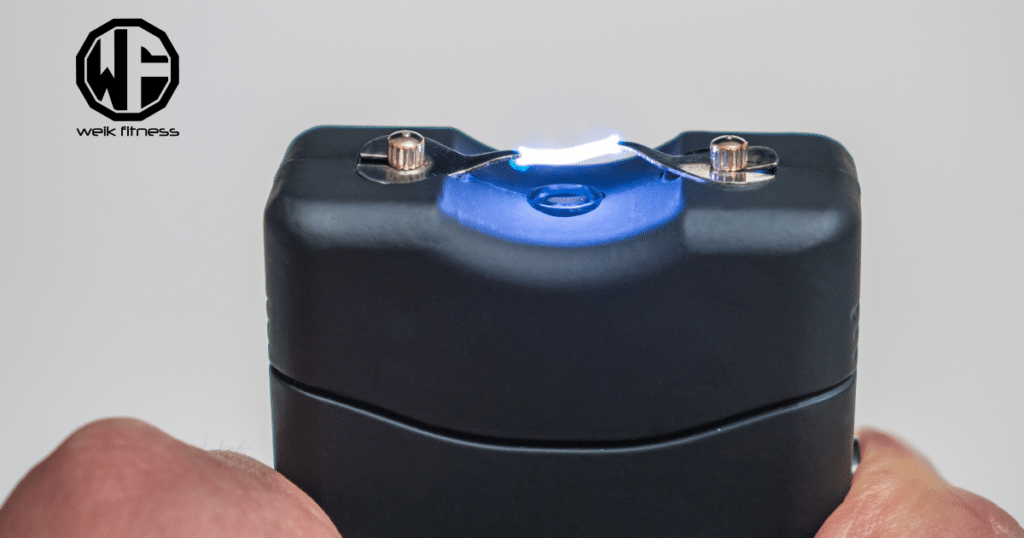
To wrap this up, both stun guns and tasers offer effective non-lethal self-defense options. Stun guns are compact and easy to carry, requiring direct contact with the attacker, while tasers can be deployed from a distance but may be more expensive.
Related Article: NPE Weapons for Non-Permissive Environments
Understanding individual preferences and needs is crucial in determining which option is best for self-defense. Both devices provide a means of protection without the use of firearms.
It’s essential to recognize their differences in operation and range when choosing between a stun gun vs taser for self-defense. Personally, I’ll choose to carry a firearm every day of the week over a stun gun or taser (that’s my personal preference). My wife, she doesn’t feel comfortable with a stun gun or taser, so she carries a POM pepper spray.
Figure out what you’re comfortable with when deciding between a stun gun vs taser, or perhaps none of them are right for you, and a blade or firearm is your preference. No matter how you slice it, you need to think about your personal defense because it’s a crazy world out there.
As a side note to close out this article, if you want to support our website and are in need of any tactical gear (or any product for that matter), anything you purchase using our links below will provide us with a small commission. We don’t charge for our free content and our goal is to keep it that way. We don’t have a Patreon account to put things behind a paywall, nor do we sell pics of our feet on OnlyFans. If you choose to use the links below and make a purchase (at no additional cost to you), we greatly appreciate your support as it helps us continue to publish free content (like this article) on our website:
- Optics Planet (use code SAS5 at checkout for 5% off)
- Amazon
And if you have a product you would like us to check out and potentially review, please contact us and let’s discuss.
FAQs of a Stun Gun vs Taser
Well, both are effective self-defense tools, but they work differently. A stun gun needs you to make direct contact with the attacker to deliver an electrical charge that causes intense pain. On the other hand, a taser can be used from a distance — it shoots out prongs attached to wires that deliver neuromuscular incapacitation.
It depends on where you live! Laws vary by location, so while tasers are often seen in law enforcement personnel’s hands, civilians need to check local laws. Some places might require you to have a permit.
Absolutely! Even though tasers are designed for distance use, they can also function like a traditional stun gun if necessary — making them versatile in tight situations.
Think about your comfort level and your unique needs. Stun guns and tasers require you to be quite close or within range of your attacker, which might not suit everyone. Pepper spray offers another option with its ability to stop someone from further away without needing precise aim.
While stun guns are generally more affordable and easy-to-use devices for self-defense, remember: any confrontation has risks involved — especially when electricity is part of the equation! Always handle these devices responsibly.
Many modern models do! Brands like VIPERTEK offer quality stun guns with rechargeable batteries built-in; this makes maintaining your device easier since you won’t need to constantly buy replacement cartridges or worry about battery life in critical moments.


*Disclosure: This article may contain affiliate links or ads, which means we earn a small commission at no extra cost to you if you make a purchase through these links. These commissions help support the operation and maintenance of our website, allowing us to continue producing free valuable content. Your support is genuinely appreciated, whether you choose to use our links or not. Thank you for being a part of our community and enjoying our content.
PLEASE CONSIDER SHARING THIS ON YOUR SOCIAL MEDIA TO HELP OTHERS LEARN MORE ABOUT THIS TOPIC. SIMPLY CLICK BELOW!

